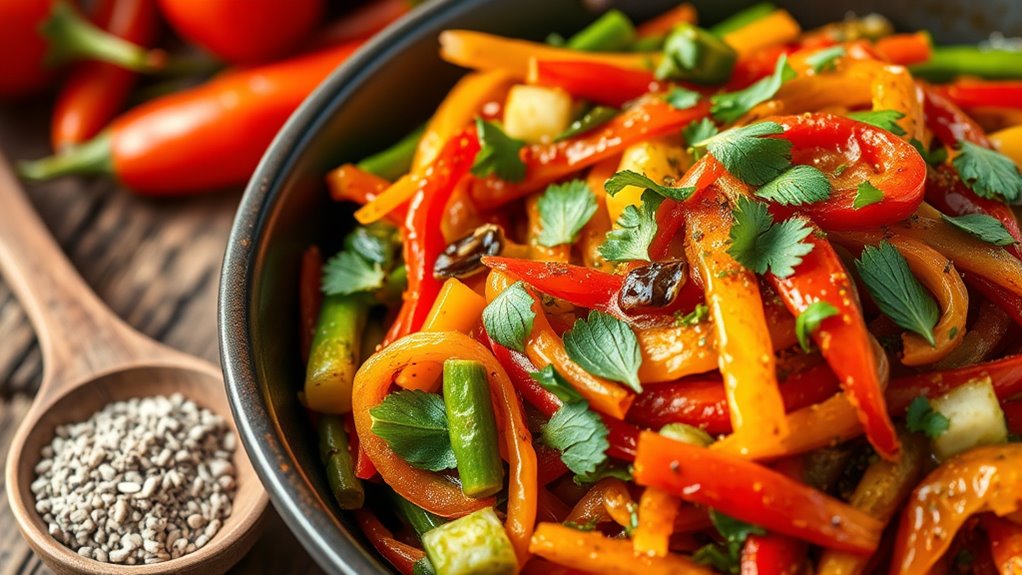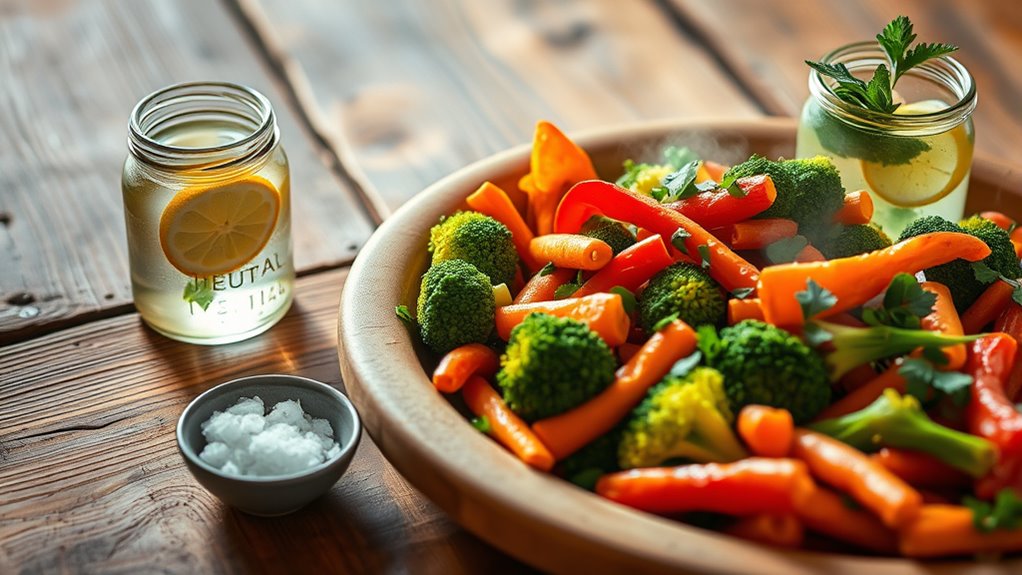To reduce sodium without losing flavor, boost your meals with herbs, spices, garlic, lemon juice, and vinegar to add depth and brightness. Use salt substitutes like potassium chloride or mineral blends to mimic saltiness healthily. Focus on high-quality, fresh ingredients and cooking techniques like roasting or grilling to enhance natural flavors. Gradually adjusting your palate helps you enjoy less salt over time. Keep exploring these strategies to make your dishes both tasty and healthy.
Key Takeaways
- Incorporate salt substitutes like potassium chloride or mineral blends to mimic saltiness without added sodium.
- Use herbs, spices, and aromatics such as garlic, lemon juice, and dried herbs to boost flavor naturally.
- Focus on cooking techniques like roasting or grilling to develop natural sweetness and umami.
- Choose fresh, high-quality ingredients to enhance natural flavor and reduce the need for salt.
- Gradually reduce salt and replace it with flavor-enhancing ingredients to allow your taste buds to adapt.

Have you ever wondered how cutting back on sodium can improve your health? Reducing your salt intake doesn’t mean your meals have to lose their deliciousness. In fact, there are plenty of ways to enhance flavor without relying heavily on salt. One effective strategy is using salt substitutes, which can mimic the salty taste but typically contain less sodium. These alternatives often include potassium chloride or other mineral blends, providing a comparable saltiness without the health risks associated with high sodium consumption. Incorporating salt substitutes into your cooking allows you to enjoy savory flavors while keeping your blood pressure in check and lowering your risk of heart disease.
Using salt substitutes can add flavor while reducing sodium intake and supporting heart health.
Flavor enhancement goes beyond just swapping out salt. You can explore a variety of herbs, spices, and aromatics to bring depth and complexity to your dishes. Fresh garlic, onions, lemon juice, and vinegar can brighten flavors and make your meals more satisfying. Dried herbs like oregano, thyme, or basil add aromatic notes that compensate for less salt. Toasting spices before adding them releases essential oils, intensifying their flavor and reducing the need for additional salt. By experimenting with these ingredients, you’ll discover new ways to make your meals more vibrant and inviting.
Another trick is to focus on the texture and presentation of your food. Crispy vegetables, colorful salads, and visually appealing plating can stimulate your senses and make meals more enjoyable without relying on salt for flavor. Additionally, cooking techniques like roasting or grilling can bring out natural sweetness and umami, creating a richer taste profile that diminishes the need for added salt. Using high-quality ingredients also makes a difference; fresher produce often tastes better and requires less seasoning to enhance its natural flavors.
You should also be mindful of processed and packaged foods, which often contain hidden sodium. Reading labels carefully can help you choose lower-sodium options and avoid excessive salt intake. When preparing homemade meals, season gradually, tasting as you go. This allows you to better control the salt level and prevents over-seasoning. Remember, you don’t have to eliminate salt entirely—just be strategic about how and when you add it.
Incorporating these approaches, especially salt substitutes and flavor enhancement techniques, empowers you to reduce sodium without sacrificing taste. Over time, your palate will adjust to less salty flavors, making healthier eating feel natural and satisfying. With a little creativity and mindful choices, you can maintain flavorful meals that support your well-being and keep your taste buds happy.
Frequently Asked Questions
Are There Natural Salt Substitutes That Taste Similar?
Yes, there are natural salt substitutes that taste similar to salt, like potassium chloride, which is often used as a flavor enhancer. You can also try seaweed or celery salt, both of which add umami and a salty kick without excess sodium. These natural options boost flavor and serve as effective flavor enhancers, helping you reduce salt intake without sacrificing taste. Just start with small amounts and adjust to your preference.
How Can I Enhance Flavor Without Adding Salt?
You can enhance flavor without adding salt by using natural salt alternatives like herbs, spices, and citrus zest. Incorporate flavor boosters such as garlic, onion, or vinegar to elevate dishes. Experiment with fresh herbs like basil, cilantro, or thyme to add depth. These options boost taste without sodium, helping you enjoy flavorful meals while maintaining a healthier diet.
Does Reducing Salt Affect Meal Preservation?
Reducing salt can affect meal preservation, but using salt alternatives like potassium chloride can help maintain freshness. You can also boost flavor with herbs, spices, and acidity, which enhance taste without depending on salt. These methods preserve your food’s quality while reducing sodium intake. By focusing on flavor enhancement through natural ingredients, you ensure your meals stay delicious and safe without sacrificing health.
Can Kids Enjoy Low-Sodium Meals?
Yes, kids can enjoy low-sodium meals, especially when you incorporate healthy snack options and focus on family meal planning. You can make meals flavorful with herbs, spices, and natural ingredients, ensuring they’re appealing without excess salt. By involving kids in choosing and preparing low-sodium dishes, you help them develop healthy eating habits while making family meals enjoyable and nutritious for everyone.
What Are the Best Herbs and Spices for Flavor?
You should try herb combinations like basil, oregano, and thyme, along with spice blends such as cumin, paprika, and cinnamon to boost flavor. These herbs and spices bring vibrant, aromatic layers to your dishes, making them taste rich and satisfying without extra salt. Mix and match herb combinations and spice blends to create complex flavors, ensuring your meals remain delicious while keeping sodium levels low.
Conclusion
By making simple swaps and using herbs or spices, you can cut back on sodium without sacrificing flavor. It’s all about experimenting and finding what works best for your taste buds. So, why settle for bland meals when you can enjoy delicious, healthier dishes? With a little creativity, you’ll find that reducing sodium doesn’t mean giving up great taste — it means discovering a whole new world of flavor. Are you ready to try it?








